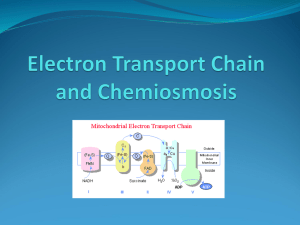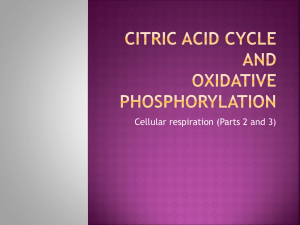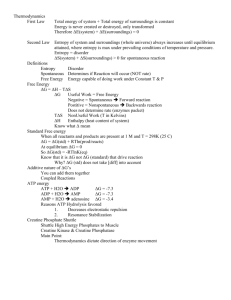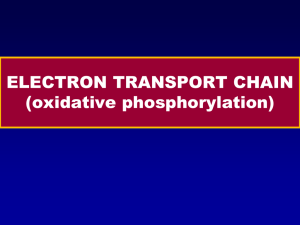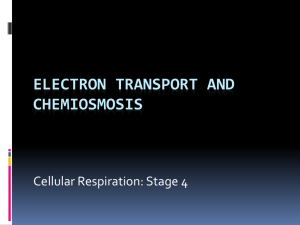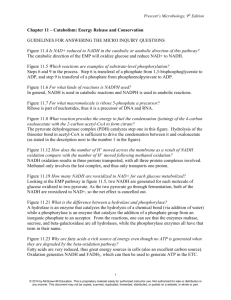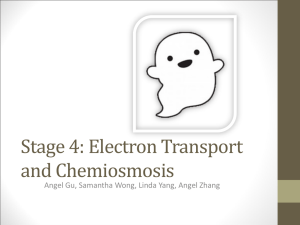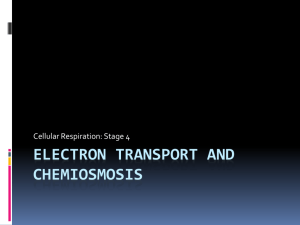Electron Transport and Chemiosmosis note
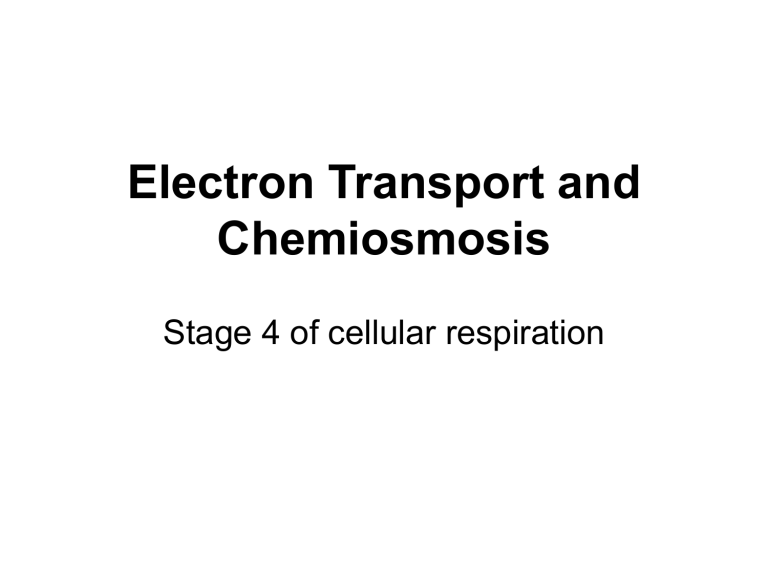
Electron Transport and
Chemiosmosis
Stage 4 of cellular respiration
The Electron transport chain (ETC)
• A series of protien complexes in the inner mitrochondrial membrane.
• Each mitochondria has many
• Complexes are organized in order of increasing electronegativity : weakest attraction for electrons first and strongest attraction at the end
• Electrons shuttle through it like a baton in a relay
• The components of the ETC in order of increasing electronegativity are: NADH dehydrogenase complex, ubiquinone (Q), the cytochrome b-c
1 complex, cytochrome c (cyt c) and the cytochrome c oxidase complex.
• Q and cyt c are carriers
From: http://giantshoulders.wordpress.com/2007/10/21/the-mitochondrion-pt-2-the-electron-transport-chain/
What happens?
• NADH and FADH
2 the ETC
(made in stages 1-3) each transfer 2 electrons to
• Free energy is released by the electrons as they travel through the chain and is used to pump one proton per complex into the intermembrane space.
• This creates an electrochemical gradient across the intermembrane space (like a battery)
• Once the electrons reach the last protein in the ETC, they are very stable, so a HIGHLY electronegative substance (OXYGEN) is used to remove them. (final electron acceptor)
• The attachment of these electrons to the oxygen attracts protons, forming water
PROCESS:
1. NADH gives up 2 electrons to NADH dehydrogenase
2. Q shuttles the electrons to cytochome b-c
1 complex
3. cytochrome shuttles the electrons to cytochrome oxidase complex
4. Cytochrome oxidase catalyzes the reaction between the electrons, free protons and oxygen to make water
NADH vs FADH
2
• NADH will transfer electrons to the first protein complex (NADH dehydrogenase) in the ETC and so pumps 3 hydrogens per molecule
• FADH
2 transfers its electrons to Q (the second protein in the ETC) and so pumps
2 hydrogens per molecule
Cytosolic vs mitrochondrial NADH
• The inner mitochondrial membrane is impermeable to NADH
• So…NADH created in glycolysis must be shuttled via a transport protein into the matrix. In doing so, it becomes FADH
2.
Chemiosmosis
• The electrochemical gradient generated during electron transport stores free energy (called proton-motive force
PMF)
• Inner mitochondrial membrane is impermeable to H+ ions
• PMF forces protons through ATP synthase and the energy from this drives the systhesis of ATP from ADP and inorganic phosphate in the matrix
• One ATP is generated per proton pumped into the intermembrane space.
• After ATP is made, it is transferred through the mitochondrial membrane by facilitated diffusion into the cytoplasm so it can do things like active transport
Interesting:
• In order for ATP to continue to be produced, an H+ reservoir must be maintained.
• This means electrons must be continually moving through the ETC
• To keep the electrons moving, oxygen must be present to accept them at the end of the chain
• Without food, there would be no electrons (this is why we must continually eat)
• If there is no oxygen, electrons will not be able to flow through the
ETC and it will become “clogged” with electrons.
• H+ ions will no longer be pumped into the intermembrane space and chemiosmosis stops, ATP synthase stops and NADH/FADH
2 are no longer able to give up electrons and can’t be recycled… organism will die due to lack of ATP if oxygen is withheld for too long.
